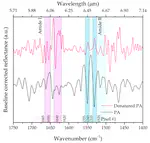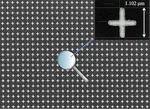REMINDS
multi-REsonant Metasurfaces for enhanced INfra-reD Spectroscopy

Mid-infrared (Mid-IR) absorption spectroscopy is a powerful method for the structural determination of molecules in chemical and biological samples, in a univocal, non-destructive, and label-free way, by measuring the absorption bands deriving from vibrational states. For these reasons, it is used to identify substances in diverse applications spanning from pharmaceutical, safety, and food to forensic sciences.
However, its stronger limitation is the very low molecular absorption cross-section of IR vibrations, which renders unpractical the characterization of minute amounts of analytes such as self-assembled monolayers (required for sensing applications) or biological membranes (naturally existing as single lipid bilayers). This fundamental limitation can be overcome in surface-enhanced IR absorption (SEIRA) spectroscopy, which relies on plasmonic metasurfaces that can be suitably engineered to strongly localized electromagnetic waves, thereby enhancing their interaction with matter. In particular, their resonant response that can be tailored so as to match the molecular vibrational mode eigenfrequency.
In a series of ongoing studies, we have focused on the optimized design and fabrication of plasmonic metasurfaces for SEIRA spectroscopy, via an innovative multiresonant design based on different pixels, each one designed to match a specific vibrational band. We have applied this approach successfully to several scenarios of great interest:
- Detection of 5-hydroxyvitamin D (25(OH)D3—calcifediol);
- Recognition of complementary deoxyribonucleic acid (DNA) fragments;
- Probing the denaturation on protein A;
at concentrations well below the value attained by standard methods, with additional advantages in terms of processing time. This technology holds great promise to outperform modern surface spectroscopic techniques, with ample room for improvement as an analytical tool for biological samples and processes.
Collaborations
- Dr. Emanuela Esposito, National Research Council, Italy
- Dr. Menotti Ruvo, National Research Council, Italy


